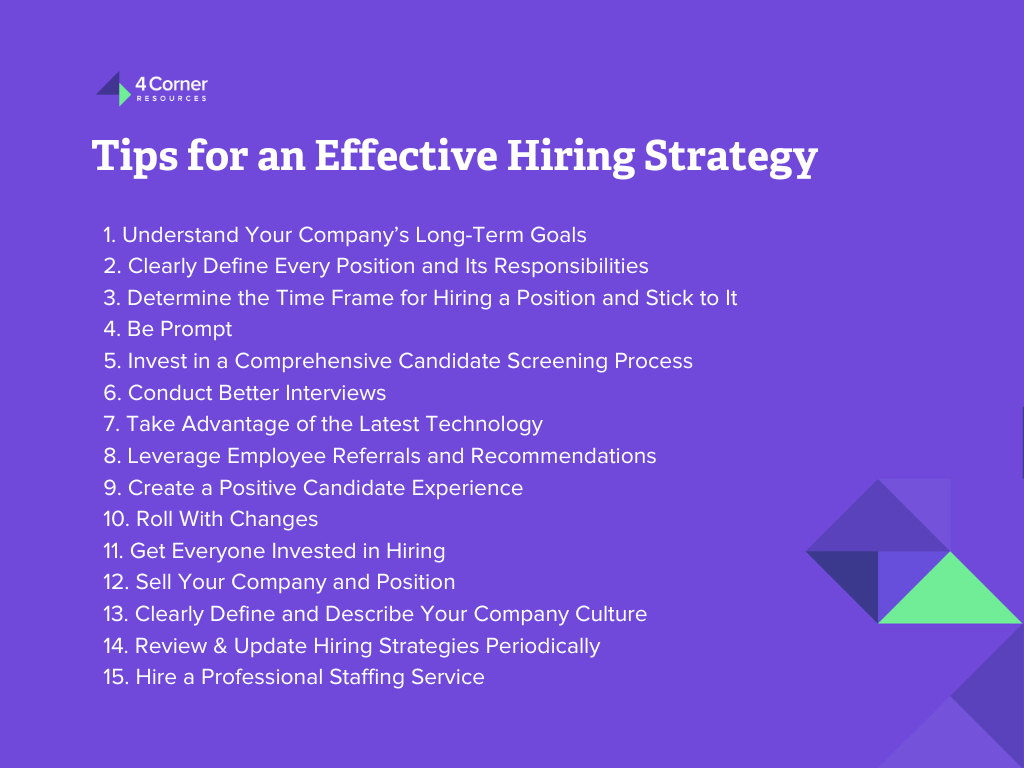How to Develop an Effective Hiring Strategy for Long-Term Success

Hiring people is easy. Recruiting, screening, and hiring the right candidates, however, is not so simple. In fact, most companies are far from perfecting the process. Nearly three in four companies admit they have been negatively impacted by a bad hire, citing lowered productivity, lost time to recruit and train another worker, and compromised quality of work as the resulting outcomes.
This is why developing and implementing an effective hiring strategy to guide your human resources team through employee recruitment and hiring is vital. When you fail to plan, you plan to fail, so your hiring and recruitment strategies are essential to helping you source, qualify, and place the right candidates in the right positions.
With these things in mind, our team of staffing experts has put together some tips for improving your organization’s employee hiring strategies and ways to incorporate innovative recruitment methods into your processes as well to achieve better results.

1. Understand Your Company’s Long-Term Goals
Before you publicize any job openings, it is crucial to get everyone involved in hiring on the same page about the company’s goals for the next three to five years. Whether the organization aims to develop new products, expand into new markets, or scale its operations, your hiring strategy should align with these goals.
The company’s long-term objectives will determine what positions need to be created, which roles should be filled first, and what characteristics hiring managers should look for to build a workforce that supports the organization’s future growth.
Related: How to Create a Recruitment Strategy Plan
2. Clearly Define Every Position and Its Responsibilities
Vague job descriptions can lead to hiring mistakes and a poor candidate experience. Ensure that each position you hire for has clearly defined expectations, responsibilities, and required skills. This will attract the right candidates and set expectations for candidates and interviewers.
The more specific you are about the goals and objectives in the position description, the more targeted your applicants will be—and the more effective your talent screening efforts will be, reducing misunderstandings and preventing future turnover.
3. Determine the Time Frame for Hiring a Position and Stick to It
Determining the date by which a candidate needs to be onboarded helps you calculate the amount of time you have available and the resources that are necessary for recruiting, evaluating, and hiring the candidate. According to the Society for Human Resource Management (SHRM), the national average time-to-hire for all industries in the U.S. is about 36 days.
Make it part of your recruitment strategy once you have determined the time frame necessary to fill a position. Hold firmly to that time frame as much as possible to ensure your hiring process stays on track and within budget. Use data from your past hiring experiences to help you determine how long it takes to bring someone on board from start to finish so you can set even more accurate expectations in the future.
4. Be Prompt
That said, when setting a time frame for recruiting, you should always work to tighten up your time-to-hire metrics. Think again if you think you can take your time scouting for and hiring candidates.
Candidates with valuable skill sets will not stay on the market for long—even a week is considered a long time in the recruitment and selection process. This is why having a speedy process as part of your strategic recruitment plan is vital to hiring the best and brightest talent.
5. Invest in a Comprehensive Candidate Screening Process
A thorough screening process is vital for making timely, informed hiring decisions. This includes reviewing resumes, conducting interviews, and using additional methods like pre-employment assessments, background checks, and reference checks.
A rigorous screening process aligned with the job requirements will help verify required skills, set candidates up for success, and ensure a strong culture fit.
6. Conduct Better Interviews
Too many companies treat every interview equally, regardless of the role or objectives. In order to ensure accurate, high-performing hires, you should tailor each interview to the particular job it aims to fill.
Develop questions that relate to the job requirements. Use a mix of technical, behavioral, and situational questions to gain a well-rounded impression of the candidate’s aptitude. Use scoring sheets to help interviewers focus on and objectively rate interviewees on the most important criteria. Compile interview feedback in a timely manner and share it among all decision-makers.
Related: The Best & Worst Interview Questions to Ask Candidates
7. Take Advantage of the Latest Technology
Technology can significantly improve and accelerate your hiring process. Applicant tracking systems (ATS) can help you keep track of applicants, maintain consistent candidate communication, and stay on top of hiring tasks. Video interview platforms allow you to speak with more candidates and expand your talent pool beyond geographical constraints. Artificial intelligence (AI) can assist with screening, aid in decision-making, and tackle laborious tasks like scheduling interviews and initiating background checks.
By utilizing modern technology, you can save time, reduce costs, eliminate tedious recruiter work, and improve your overall hiring quality.
Find the perfect fit for your team.
Speak to one of our recruiting experts today.
8. Leverage Employee Referrals and Recommendations
Although not one of the most innovative recruitment methods, gathering candidate referrals from your top-performing employees is a great way to recruit talent. It is one of those employee recruitment strategies that benefits everyone because:
- You get trustworthy and reliable talent to fill your vacant positions;
- Your employees can be rewarded with a bonus or “finder’s fee” of sorts; and
- Their referral gets them to start a position with your organization.
9. Create a Positive Candidate Experience
A positive candidate experience can set your company apart in today’s competitive job market. From your first interaction with a prospective applicant to the final offer, ensure every touchpoint is professional, respectful, and personalized.
Clear communication, timely updates, and thoughtful feedback during the interview process can make a lasting good impression even if a candidate is not hired. These efforts contribute to a strong employer brand and help consistently attract high-quality talent.
10. Roll With Changes
The rules of recruiting have changed, and it is vital that you change with them. Technological advancements, economic shifts, and shifts in candidate expectations can all call for updates to your hiring strategy.
From setting up virtual onboarding that accommodates remote workers to offering the perks and benefits top candidates want most, adapting to the new normal will give you an advantage in the ever-evolving hiring market. You’ll also need to be flexible to adapt to rapidly changing technology, staying agile to accommodate candidate preferences and help recruiters move quickly.
11. Get Everyone Invested in Hiring
While the hiring process is vital to the employee recruitment strategies of a recruiter or hiring manager, it should also be a priority for everyone across your organization—everyone from the top executives to the front-line managers. If the recruitment and selection process is a top priority, it means you will spend less time chasing people down to get them to:
- Review resumes;
- Commit to interviews;
- Provide timely feedback; and
- Make a hiring decision.
According to a LinkedIn article, Netflix is one major organization that has embraced a collaborative approach to creating a pro-hiring culture. Among the attributes that make Netflix’s recruitment and hiring strategies different from many conventional corporations is that:
- Everyone is responsible for recruiting;
- Hiring managers have more freedom and ownership over hiring decisions; and
- Recruiters and hiring managers communicate directly and honestly.
Related: Collaborative Hiring: How to Involve Your Employees
12. Sell Your Company and Position
One of the most essential components of the recruitment and selection process is selling both your company and the job to prospective employees. If you have trouble doing that, you have a problem, so it’s in your best interest to fix it as soon as possible.
Top candidates often have multiple offers, so you’ll need to spell out how they will benefit from selecting yours. Use a variety of mediums to showcase your company’s strengths, workplace culture, growth opportunities, values, and benefits. Incorporate this messaging into your recruitment marketing materials, interview conversations, and candidate communications.
This brings us to our next tip…
13. Clearly Define and Describe Your Company Culture
Having a strong organizational culture is about knowing and supporting your company’s mission and values. This means that you’ll want to hire people who are a good culture fit for your organization—people whose values, beliefs, and behaviors align with those of your organization.
To ensure you find the right candidates who fit these parameters, clearly define your culture and be quick to describe it to prospective employees, an important part of your recruitment plan.
14. Review & Update Hiring Strategies Periodically to Reflect Changes
A high-quality hiring strategy is not something that, once created, is put on a shelf to collect dust. It is a living document that needs to be reviewed and updated periodically. After you create and implement a hiring or recruitment strategy, it is essential to go back regularly and update it based on what worked well or did not during the hiring process.
This approach helps you use the knowledge you gain from each hiring experience. It also provides a reason to ask others for input or recommendations on improving your organization’s hiring strategy and adopting more creative recruitment strategies.
15. Hire a Professional Staffing Service
Partnering with a professional recruiting and staffing agency or a headhunter does not mean that you are a bad or incompetent hiring manager. Working with a company like 4 Corner Resources as part of your recruitment strategy frees you up to focus on moving the needle for your company’s core mission and business objectives.
Our team at 4 Corner Resources spends each day shoulder-to-shoulder with clients seeking to fill vacant positions. As part of our recruitment strategy, we consider various factors—the client’s time frame, goals, and the culture fit of each candidate—when screening and placing candidates with every company.
Contact our team of recruiting and staffing experts today to learn how 4CR can help place the best candidates with your business.
